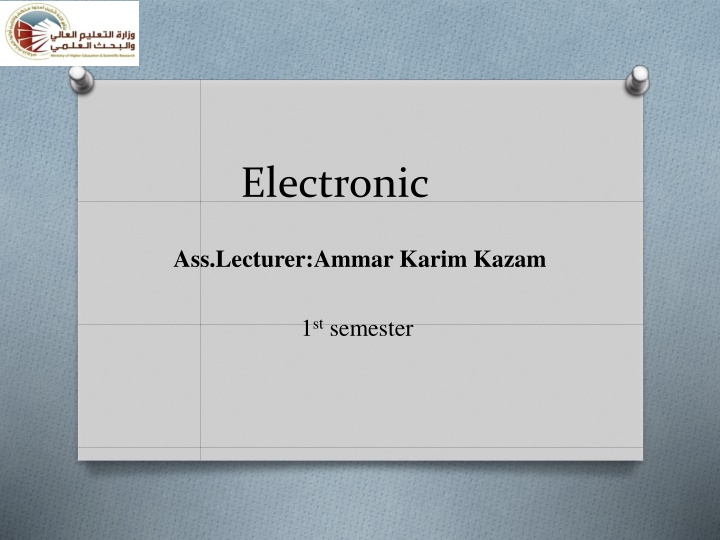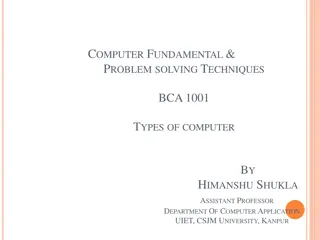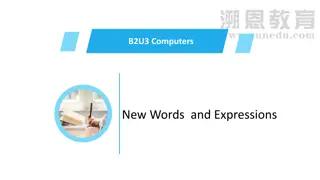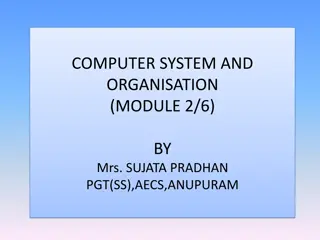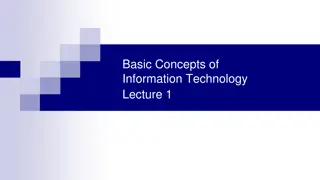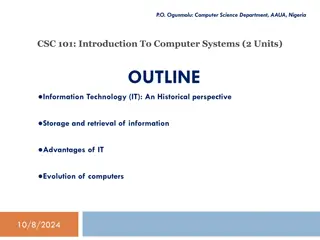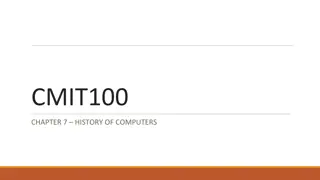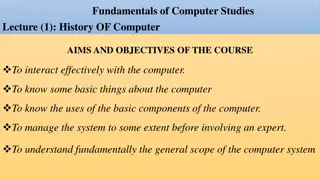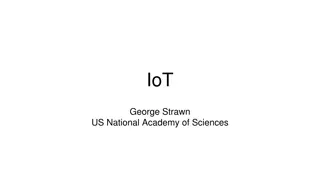Evolution of Computers: Exploring Five Generations
Computers have evolved through five generations, each characterized by technological advancements. From the room-sized machines of the first generation to the smaller and more efficient second generation with transistors, this journey showcases the evolution of computing technology. Vacuum tubes, punched cards, magnetic tape, and more played crucial roles in shaping these generations. Despite advantages such as being the first electronic devices with memory, these early computers faced challenges like bulkiness, frequent vacuum tube burnouts, and maintenance issues.
Download Presentation

Please find below an Image/Link to download the presentation.
The content on the website is provided AS IS for your information and personal use only. It may not be sold, licensed, or shared on other websites without obtaining consent from the author.If you encounter any issues during the download, it is possible that the publisher has removed the file from their server.
You are allowed to download the files provided on this website for personal or commercial use, subject to the condition that they are used lawfully. All files are the property of their respective owners.
The content on the website is provided AS IS for your information and personal use only. It may not be sold, licensed, or shared on other websites without obtaining consent from the author.
E N D
Presentation Transcript
Electronic Ass.Lecturer:Ammar Karim Kazam 1stsemester
Chapter Two Diode and its Application Lecture 2 2
Diode Diode is a semiconductor device, made from a small piece of semiconductor material, such as silicon. It is consist of two part that divided in equal, the firsthalf is doped as a p region and second half is doped as an n region. Theses two part with the depletion region in between produced the pn junction. The p region is called the anode and n region is called the cathode. It conducts current in one direction and offers high resistance in other direction. The basic diode structure and symbol are shown in Fig.1. 3
Forward Bias Bias is the application of a dc voltage to a diode to make it either conduct current or not. Forward bias is the condition that allows current through the pn junction. This external bias voltage is designated as VBIAS. The resistor limits the forward current to a value that will not damage the diode. In the forward bias, the negative side of VBIAS is connected to the n region of the diode and the positive side is connected to the p region. The bias voltage VBIAS, must be greater than the barrier potential; bias must be greater than 0.3V for germanium or 0.7V for silicon diodes. 4
Negative side of bias voltage pushes free electrons towards pn junction. The negative side of the source also provides a continuous flow of electrons through the external connection (conductor) and into the n region as shown in Figure 3. The bias-voltage source imparts sufficient energy to the free electrons for them to overcome the barrier potential of the depletion region and move on through into the p region. Since unlike charges attract, the positive side of the bias-voltage source attracts the valence electrons toward the left end of the p region. The holes in the p region provide the medium for these valence electrons to move through the p region. The holes, (majority in p region), move to the right toward the junction. As the electrons flow out of the p region through the external connection (conductor), these electrons become conduction electrons in the metal conductor. As more electrons move into the depletion region, the number of positive ions is reduced. As more holes flow into the depletion region on the other side of the pn junction, the number of negative ions is reduced. This reduction in positive and negative ions causes the depletion region to narrow. 5
Reverse Bias Reverse bias is the condition that essentially prevents current through the diode. Figure 4 shows a dc voltage source connected across a diode in the direction to produce reverse bias. The positive side of VBIAS is connected to the n region of the diode and the negative side is connected to the p region. Also, note that the depletion region is shown much wider than in forward bias or equilibrium. The positive side of the bias-voltage source pulls the free electrons, (majority in n region), away from the pn junction. As electrons move away from junction, more positive ions are created. This results in a widening of the depletion region and a depletion of majority carriers. 6
Reverse Bias In p region, electrons from negative side of battery enter as valence electrons. It moves from hole to hole toward the depletion region, creating more negative ions. This can be viewed as holes being pulled towards the negative side. The electric field increases in strength until the potential across the depletion region equals the bias voltage. At this point, very small reverse current exist that can usually be neglected. 7
Voltage-Current (V-I) Characteristic of A Diode V-I Characteristic for Forward Bias The current in forward biased called forward current and is designated If. At 0V (Vbias) across the diode, there is no forward current. Figure 5 illustrates what happens as the forward-bias voltage is increased positively from 0 V. The resistor is used to limit the forward current to a value that will not overheat the diode and cause damage. Figure 5: Relationship of voltage and current in a forward-biased diode. 8
With gradual increase of Vbias, the forward voltage and forward current increases. A portion of forward-bias voltage (Vf) drops across the limiting resistor. Continuing increase of Vf causes rapid increase of forward current but the voltage across the diode increases only gradually above 0.7V. The resistance of the forward-biased diode is not constant but it changes over the entire curve. Therefore, it is called dynamic resistance. 9
V-I Characteristic for Reverse Bias With 0V reverse voltage there is no reverse current. There is only a small current through the junction as the reverse voltage increases. At a point, reverse current shoots up with the breakdown of diode. The voltage called breakdown voltage. This is not normal mode of operation. After this point the reverse voltage remains at approximately VBR but IR increase very rapidly. Break down voltage depends on doping level, set by manufacturer. 10
Combine the curves for both forward bias and reverse bias, and you have the complete V-I characteristic curve for a diode, as shown in Figure 6. 11
Diode models The Ideal Diode Mode 1- When the diode is forward-biased, it ideally acts like a closed (on) switch, as shown in Figure 7. 2- When the diode is reverse-biased, it ideally acts like an open (off) switch, as shown in part (b). The barrier potential, the forward dynamic resistance, and the reverse current are all neglected. In Figure 7c, the ideal V-I characteristic curve graphically depicts the ideal diode operation. 12
The Practical Diode Model The practical model includes the barrier potential. The characteristic curve for the practical diode model is shown in Figure 8c. Since the barrier potential is included and the dynamic resistance is neglected, the diode is assumed to have a voltage across it when forward-biased, as indicated by the curve to the right of the origin. The practical model is useful in lower-voltage circuits and in designing basic diode circuits. The forward current is determined using first Kirchhoff s voltage law to Figure 8a: 13
Example 1: (a) Determine the forward voltage and forward current for the diode in Figure 10 (a) for each of ideal and practical diode models. Also, find the voltage across the limiting resistor in each case. (b) Determine the reverse voltage and reverse current for the diode in Figure 10(b) for each of the diode models. Also, find the voltage across the limiting resistor in each case. Assume IR = 1 A. (H.W.) 15
The DC power supply A power supply is an essential part of each electronic system from the simplest to the most complex. A basic block diagram of the complete power supply is shown in the below Figure. The transformer changes ac voltages based on the turns ratio between the primary and secondary. The rectifier converts the ac input voltage to dc voltage. The filter eliminates the fluctuations in the rectified voltage and produces a relatively smooth dc voltage. The regulator is a circuit that maintains a constant dc voltage for variations in the input line voltage or in the load. 16
Half-Wave Rectifiers Because of their ability to conduct current in one direction and block current in the other direction, diodes are used in circuits called rectifiers that convert AC voltage into DC voltage. Rectifiers are found in all dc power supplies that operate from an ac voltage source. When connected with ac voltage, diode only allows half cycle passing through it and hence convert ac into dc. As the half of the wave get rectified, the process called half-wave rectification. The output frequency is the same as the input. 17
The average value (VAVG) of half-wave rectified voltage if its peak amplitude is 50 V is VAVG = VP/ = 50/3.14 = 15.9V , VAVG is approximately 31.8% of Vp PIV= Vp(in) 18
PIV: Peak inverse voltage = is the maximum voltage occurs at the peak of each half-cycle of the input voltage when the diode is reverse-biased. The diode must be capable of withstanding this amount voltage. Figure 13 19
Full wave rectifiers Although half-wave rectifiers have some applications, the full-wave rectifier is the most commonly used type in dc power supplies. A full-wave rectifier allows unidirectional (one-way) current through the load during the entire of the input cycle. Whereas, a half-wave rectifier allows current through the load only during one-half of the cycle. The output voltage have twice the input frequency. VAVG = 2VP/ = VAVG is approximately 63.7 % of Vp Figure 14 20
Center-Tapped Full-Wave Rectifier Operation A center-tapped rectifier is used two diodes that connected to the secondary of a center-tapped transformer, as shown in Figure 14. Figure 16: Basic operation of a center-tapped full-wave rectifier. 21
The Bridge Full-wave rectifiers The Bridge Full-Wave rectifier uses four diodes connected across the entire secondary as shown in Figure 16 22
Diode Limiters Diode circuits, called limiters or clippers, are used to clip off portions of signal voltages above or below certain levels. Point A is limited to +0.7V when the input voltage exceeds this value (Figure 18(a)). If the diode is turned around, as in Figure 18(b), the negative part of the input voltage is clipped off. When the diode is forward-biased during the negative part of the input voltage, point A is held at -0.7V by the diode drop. Figure 18: Examples of diode limiters (clippers). 23
The desired amount of limitation can be attained by a power supply or voltage divider. The amount clipped can be adjusted with different levels of VBIAS. The peak output voltage across RL is determine by the following equation: ?? ????= ??? ?1+ ?? 24
Example 2: What would you expect to see displayed on an oscilloscope connected across RL in the limiter shown in following Figure. Solution: The diode is forward-biased and conducts when the input voltage goes below -0.7V. So, for the negative limiter, determine the peak output voltage across RL by: ?? ?1+ ?? The scope will display an output waveform as shown in following Figure 100k 110k ????= ???= 10V = 9.09V 25
Diode Clampers Another type of diode circuit, called a clamper, is used to add or restore a dc level to an electrical signal. The capacitor charges to the peak of the supply minus the diode drop. Once charged the capacitor acts like a battery in series with the input voltage. The AC voltage will ride along with the DC voltage. The polarity arrangement of the diode determines whether the DC voltage is negative or positive. 26
Voltage Multiplier Voltage multipliers use clamping action to increase peak rectified voltages without the necessity of increasing the transformer s voltage rating. Multiplication factors of two, three, and four are common. Voltage multipliers are used in high-voltage, low-current applications such as cathode-ray tubes (CRTs) and particle accelerators. In the Figure 20 a half-wave voltage doubler, a voltage doubler is a voltage multiplier with a multiplication factor of two. Once C1 and C2 charges to the peak voltage, it is act like two batteries in series, effectively doubling the voltage output. The current capacity for voltage multipliers is low. 27
The full-wave voltage doubler arrangement of diodes and capacitors takes advantage of both positive and negative peaks to charge the capacitors giving it more current capacity. Voltage triplers and quadruplers utilize three and four diode-capacitor arrangements, respectively. 28
Typical diode packages with terminal identification. The letter K is used for cathode to avoid confusion with certain electrical quantities that are represented by C. Case type numbers are indicated for each diode. 29
